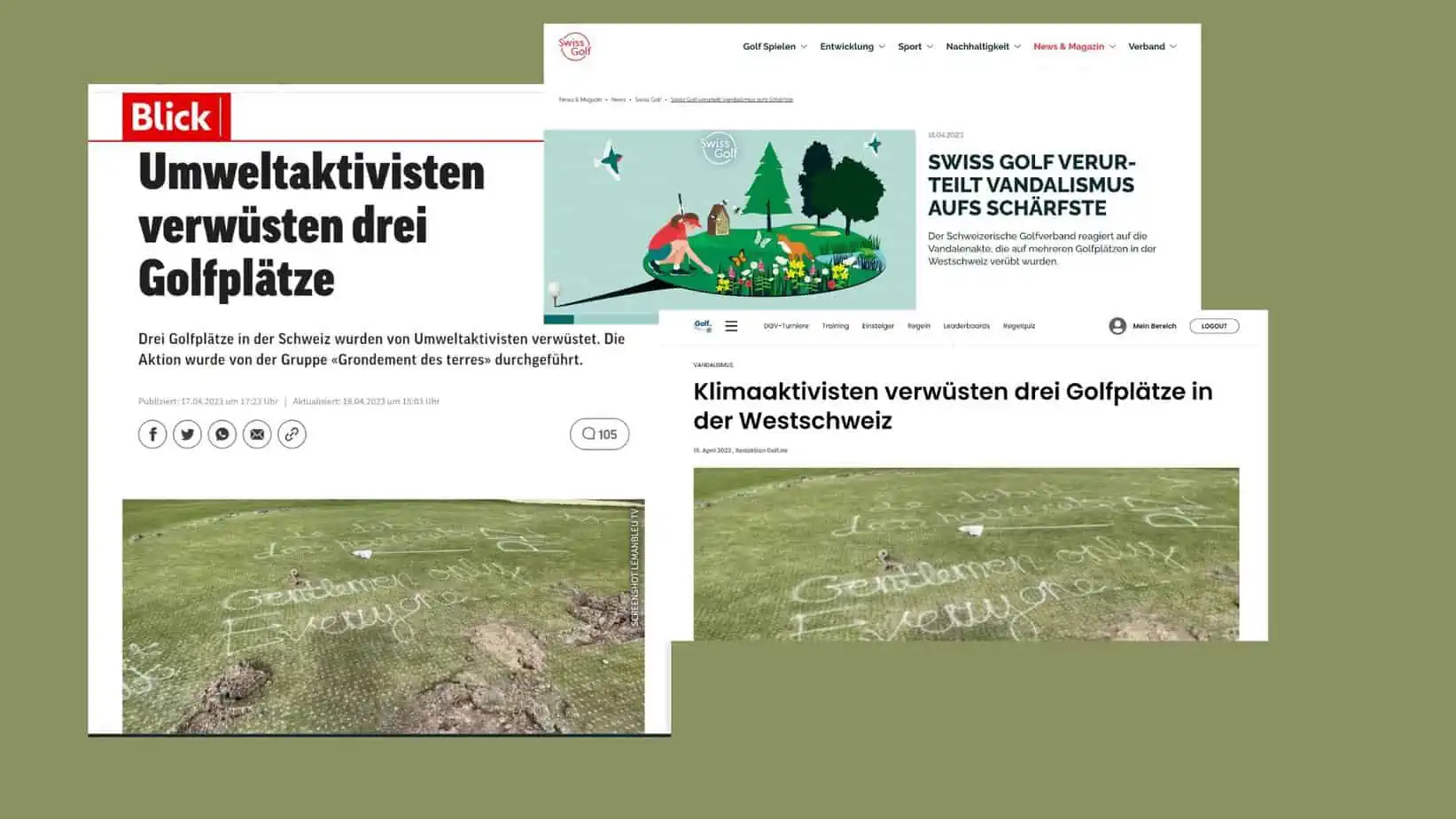Vandalism in golf: Water also the issue in Switzerland
After the devastation of three golf courses by the Swiss environmental group Grondement des terres during the past two weeks, the Swiss golf scene has begun to come to terms with the incident. After the discovery of torn and graffitied greens not only at the Geneva Golf Club on Monday morning, but also the Lausanne and Payerne golf clubs were affected by vandalism, repair work has long been underway at the golf facilities. The damage to the golf courses appears to be repairable.
Vandalism also in France
In addition, however, the question arises as to how the golf industry itself is dealing with the incident, which is not the first of its kind in Europe. At the same time, it appears that water consumption in golf is becoming more and more of a global issue. Last summer, some of the flagpole holes on French golf courses had been filled with concrete, following a heated debate in the country over the use of water during the country’s ongoing drought. In Switzerland, too, the environmental activists now justified their act with the water issue. Worldwide, they claim, 9.5 billion liters of water are used daily for golf courses. This is almost the amount of water that mankind drinks in a day.
Although Swiss golf courses were not affected by water shortages to the same extent last summer as, say, golf courses in Italy, France, parts of England or Germany, Reto Bieler, president of SwissGolf, expects that “water will become a key issue.” The consequences for Swiss Golf have been clear for some time and were already described in 2019 in the sustainability strategy Golf Course 2030. “On the one hand, we have to look at grass varieties that require far less water and also make sure on the field that we are generally conserving water. It’s also about managing expectations. We have to make it clear to our golfers that they can’t expect golf courses to be as green as they have been in the long run, but that this doesn’t have to mean a drop in quality.”
Swiss Golf is currently unable to make any concrete statements on the water consumption of the affected golf courses. Reporting on water, said sustainability manager Alicia Moulin, is still a work in progress with certifier GEO and has not yet been completed. In addition, a working group is busy developing a strategy.
Independently of the water issue, however, the arguments of the environmental group Grondement des Terres that golf is one of the most environmentally damaging sports of all and takes up more space than public parks in Switzerland also point to the social criticism of the action. Golf facilities in Europe are always struggling with this kind of criticism, which is not substantiated. They are also used as a symbol of wealth and exclusivity. “Let’s take the land back from the rich, it starts with the golf courses,” the Swiss activists write on their website.
According to Bieler, a confrontation of rich against poor on the back of golf can hardly be countered. “We can only point out that we have long begun to open the sport to a large part of the population. About 40 percent of Swiss Golf’s members practice golf through Migros Golf Clubs or ASGI, an association for club-free golfers, he explains. “We are talking about a contribution of around 300 francs per year.” Nevertheless, Bieler has noted in recent days, it may well be that the image of golf courses is increasingly back in the public eye.
Swiss Golf pushes sustainability
The fact that the environmentalists’ protest included Geneva and Lausanne, two of Switzerland’s most exclusive golf clubs, suggests that. When it comes to environmental protection, however, Swiss Golf is considered one of the most progressive associations within the European golf scene. 32 of the association’s 98 member clubs have already been certified by the internationally recognized GEO Foundation, and the golf clubs in Payerne and Lausanne are among them. The golf facility in Geneva has also already begun the certification process. This means that the percentage of certified clubs in Switzerland is significantly higher than in Germany, Austria or England, for example.
Strengthen communication
A fact that is now to be emphasized even more strongly in Swiss Golf’s communication. “We have to make it even clearer that the greens, with their intensive maintenance, really only make up two percent of the golf course,” Bieler issues as a slogan. A toolbox is currently being developed for Swiss golf clubs, which will contain argumentation aids and explanations on the subject of the environment and sustainability.
The Swiss incident could be taken as a warning call by other golf associations in Europe. Italy and France have already been experiencing a profound drought for months. England Golf pointed out in a post on social media just earlier this week that watering restrictions had been imposed in individual regions. So the debate over water consumption in golf is likely to continue.







